高分子材料工程专业英语第二版课文翻译基本全了
高分子材料工程专业英语翻译
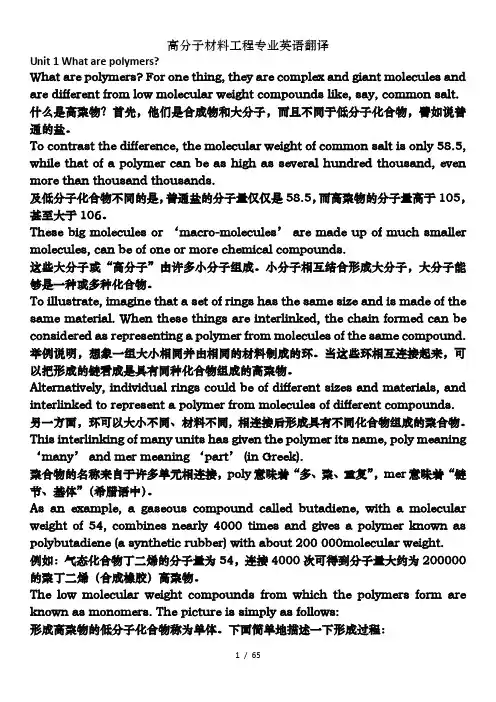
Unit 1 What are polymers?What are polymers? For one thing, they are complex and giant molecules and are different from low molecular weight compounds like, say, common salt.什么是高聚物?首先,他们是合成物和大分子,而且不同于低分子化合物,譬如说普通的盐。
To contrast the difference, the molecular weight of common salt is only 58.5, while that of a polymer can be as high as several hundred thousand, even more than thousand thousands.及低分子化合物不同的是,普通盐的分子量仅仅是58.5,而高聚物的分子量高于105,甚至大于106。
These big molecules or ‘macro-molecules’ are made up of much sma ller molecules, can be of one or more chemical compounds.这些大分子或“高分子”由许多小分子组成。
小分子相互结合形成大分子,大分子能够是一种或多种化合物。
To illustrate, imagine that a set of rings has the same size and is made of the same material. When these things are interlinked, the chain formed can be considered as representing a polymer from molecules of the same compound.举例说明,想象一组大小相同并由相同的材料制成的环。
高分子专业英语课文翻译
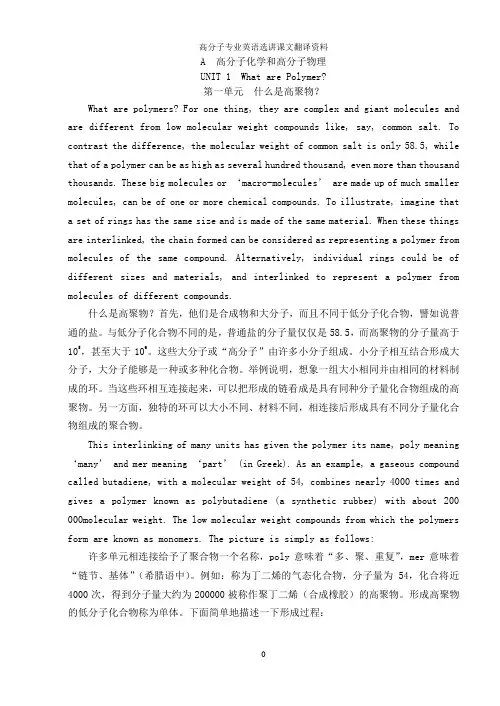
A 高分子化学和高分子物理UNIT 1 What are Polymer?第一单元什么是高聚物?What are polymers? For one thing, they are complex and giant molecules and are different from low molecular weight compounds like, say, common salt. To contrast the difference, the molecular weight of common salt is only 58.5, while that of a polymer can be as high as several hundred thousand, even more than thousand thousands. These big molecules or ‘macro-molecules’ are made up of much smaller molecules, can be of one or more chemical compounds. To illustrate, imagine that a set of rings has the same size and is made of the same material. When these things are interlinked, the chain formed can be considered as representing a polymer from molecules of the same compound. Alternatively, individual rings could be of different sizes and materials, and interlinked to represent a polymer from molecules of different compounds.什么是高聚物?首先,他们是合成物和大分子,而且不同于低分子化合物,譬如说普通的盐。
材料科学与工程专业英语第二版课文翻译(1,2,3,10)
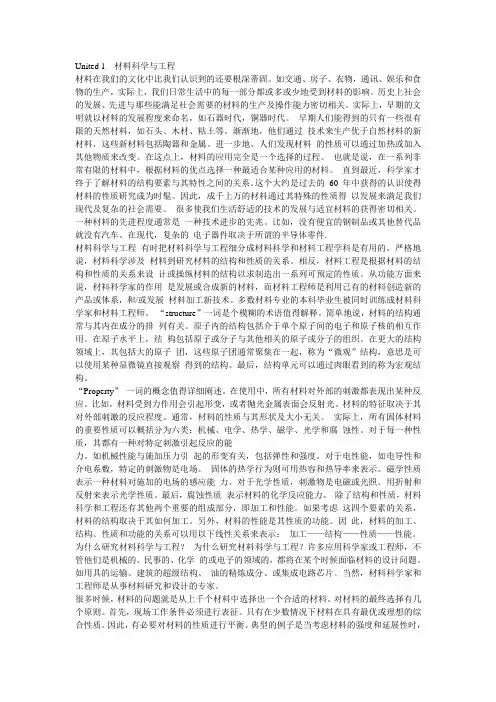
United 1 材料科学与工程材料在我们的文化中比我们认识到的还要根深蒂固。
如交通、房子、衣物,通讯、娱乐和食物的生产,实际上,我们日常生活中的每一部分都或多或少地受到材料的影响。
历史上社会的发展、先进与那些能满足社会需要的材料的生产及操作能力密切相关。
实际上,早期的文明就以材料的发展程度来命名,如石器时代,铜器时代。
早期人们能得到的只有一些很有限的天然材料,如石头、木材、粘土等。
渐渐地,他们通过技术来生产优于自然材料的新材料,这些新材料包括陶器和金属。
进一步地,人们发现材料的性质可以通过加热或加入其他物质来改变。
在这点上,材料的应用完全是一个选择的过程。
也就是说,在一系列非常有限的材料中,根据材料的优点选择一种最适合某种应用的材料。
直到最近,科学家才终于了解材料的结构要素与其特性之间的关系。
这个大约是过去的60 年中获得的认识使得材料的性质研究成为时髦。
因此,成千上万的材料通过其特殊的性质得以发展来满足我们现代及复杂的社会需要。
很多使我们生活舒适的技术的发展与适宜材料的获得密切相关。
一种材料的先进程度通常是一种技术进步的先兆。
比如,没有便宜的钢制品或其他替代品就没有汽车。
在现代,复杂的电子器件取决于所谓的半导体零件.材料科学与工程有时把材料科学与工程细分成材料科学和材料工程学科是有用的。
严格地说,材料科学涉及材料到研究材料的结构和性质的关系。
相反,材料工程是根据材料的结构和性质的关系来设计或操纵材料的结构以求制造出一系列可预定的性质。
从功能方面来说,材料科学家的作用是发展或合成新的材料,而材料工程师是利用已有的材料创造新的产品或体系,和/或发展材料加工新技术。
多数材料专业的本科毕业生被同时训练成材料科学家和材料工程师。
“structure”一词是个模糊的术语值得解释。
简单地说,材料的结构通常与其内在成分的排列有关。
原子内的结构包括介于单个原子间的电子和原子核的相互作用。
在原子水平上,结构包括原子或分子与其他相关的原子或分子的组织。
高分子材料工程专业英语课文翻译
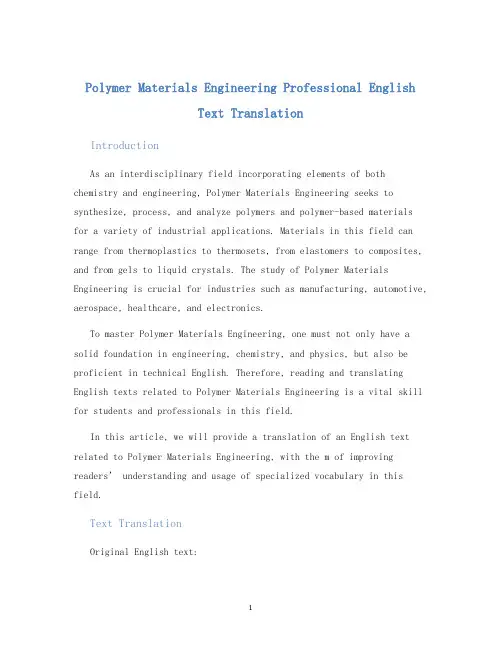
Polymer Materials Engineering Professional EnglishText TranslationIntroductionAs an interdisciplinary field incorporating elements of both chemistry and engineering, Polymer Materials Engineering seeks to synthesize, process, and analyze polymers and polymer-based materialsfor a variety of industrial applications. Materials in this field can range from thermoplastics to thermosets, from elastomers to composites, and from gels to liquid crystals. The study of Polymer Materials Engineering is crucial for industries such as manufacturing, automotive, aerospace, healthcare, and electronics.To master Polymer Materials Engineering, one must not only have a solid foundation in engineering, chemistry, and physics, but also be proficient in technical English. Therefore, reading and translating English texts related to Polymer Materials Engineering is a vital skill for students and professionals in this field.In this article, we will provide a translation of an English text related to Polymer Materials Engineering, with the m of improving readers’ understanding and usage of specialized vocabulary in this field.Text TranslationOriginal English text:Rightly or wrongly, a connection often is made between themechanical performance of a polymeric material and its degree of crystallinity. The inference, however, can be incorrect as many other factors affect the mechanical response of polymer materials. Simply stated, crystalline regions are usually stronger and stiffer than amorphous regions. Generally, the degree of crystallinity that yields optimum properties depends on the polymer type and on the application.Translated text:通常我们会认为高分子材料的力学性能与其结晶度相关联,这种推论并不总是正确的。
(完整word版)高分子材料工程专业英语第二版课文翻译(基本全了
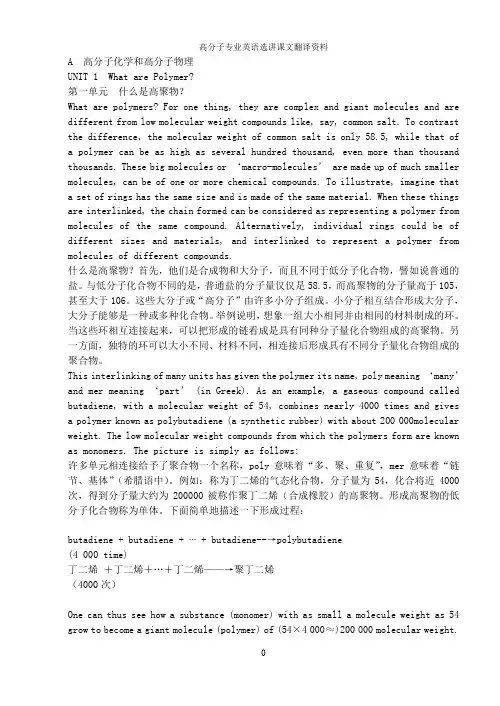
A 高分子化学和高分子物理UNIT 1 What are Polymer?第一单元什么是高聚物?What are polymers? For one thing, they are complex and giant molecules and are different from low molecular weight compounds like, say, common salt. To contrast the difference, the molecular weight of common salt is only 58.5, while that of a polymer can be as high as several hundred thousand, even more than thousand thousands. These big molecules or ‘macro-molecules’ are made up of much smaller molecules, can be of one or more chemical compounds. To illustrate, imagine that a set of rings has the same size and is made of the same material. When these things are interlinked, the chain formed can be considered as representing a polymer from molecules of the same compound. Alternatively, individual rings could be of different sizes and materials, and interlinked to represent a polymer from molecules of different compounds.什么是高聚物?首先,他们是合成物和大分子,而且不同于低分子化合物,譬如说普通的盐。
高分子材料工程专业外语第二版(UNIT23-32译文)
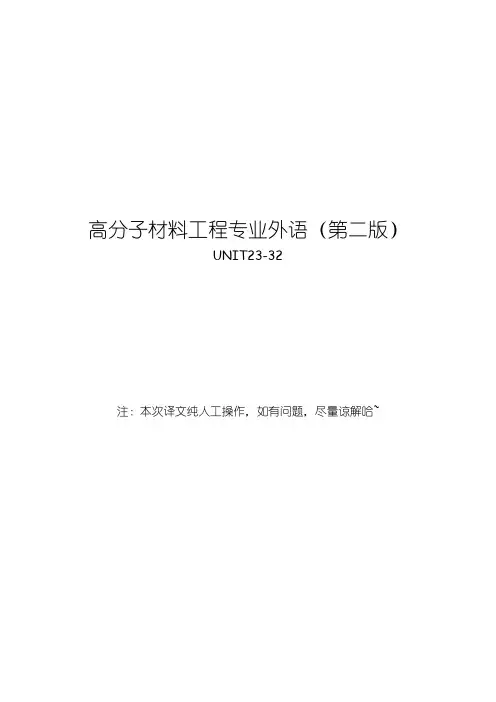
高分子材料工程专业外语(第二版)UNIT23-32注:本次译文纯人工操作,如有问题,尽量谅解哈~UNIT 23 聚合物加工在其最一般的情况下,聚合物加工涉及固态(有时是液态)聚合物树脂以一种不规则的形式(如:粉状、球状、珠粒状)转化成一种具有特殊形状、尺寸和性能的固态塑料制品。
这通过转变过程来实现:挤出、模塑、压延、涂覆、热成型等。
为了实现上面的目的,加工过程通常涉及下述操作:固体输送、压缩、加热、熔融、混合、成型、冷却、固化及修饰。
显然,这些操作不必按序发生,而许多可以同时发生。
通过成型可以赋予材料所需要的几何形状和尺寸。
它包括黏弹性形变和热成型,这种黏弹性形变和热传递是和产品从熔体的固化相联系的。
成型包括:(1)二维操作,如:口模成型、压延及涂覆。
(2)三维的模塑和成型操作。
二维的操作要么是连续的固定队的形状(如:薄膜及片材挤出、电线的涂层、纸和片材涂覆、压延、纤维纺丝、管材和型材挤出等),要么是间歇式的,在挤出的情况下伴有间歇挤出吹膜。
通常模塑成型操作是间歇式的,然而它们倾向于非固定条件。
热成型、真空成型及类似过程可以被看做是二次成型操作,因为它们通常包括已成型形状的再次成型。
在某些情况下,像吹塑,加工包括首次成型(型坯形成)和二次成型(型坯膨胀)。
成型操作包括同时或交错的液体流动和热传递。
在二维加工中,固化伴随着成型加工,反之在三维加工的固化和成型往往在模具中同时发生。
根据材料的性质、设备和加工条件的不同,流动形式以及根据流动面的自由与否,通常包含剪切流动、拉伸流动及挤压流动。
经历了流动和固化的聚合物热机械历史导致了加工产品中微观结构(形态学、结晶度及取向分布)的发展。
产品的最终性能与微观结构是紧密相关的。
因此,加工和产品质量的控制必须基于在树脂性能、设备设计、操作条件、热机械历史、微观结构和最终产品性能之间相互作用的了解。
数学建模和计算机模拟被同时用于获得这些相互间作用的了解。
鉴于进一步利用计算机辅助设计/计算机辅助制造/计算机辅助工程(CAD/CAM/CAE)系统协同塑料塑料加工诸如这一趋近获得了更多的重要性。
高分子材料与工程专业英语翻译
A 高分子化学和高分子物理UNIT 1 What are Polymer?第一单元什么是高聚物?What are polymers? For one thing, they are complex and giant molecules and are different from low molecular weight compounds like, say, common salt. To contrast the difference, the molecular weight of common salt is only 58.5, while that of a polymer can be as high as several hundred thousand, even more than thousand thousands. These big molecules or ‘macro-molecules’are made up of much smaller molecules, can be of one or more chemical compounds. To illustrate, imagine that a set of rings has the same size and is made of the same material. When these things are interlinked, the chain formed can be considered as representing a polymer from molecules of the same compound. Alternatively, individual rings could be of different sizes and materials, and interlinked to represent a polymer from molecules of different compounds.什么是高聚物?首先,他们是合成物和大分子,而且不同于低分子化合物,譬如说普通的盐。
高分子材料专业英语第二版(曹同玉,冯连芳,张菊华)课后例句翻译
Unit11.The essentially the ‘giantness’of the size of the polymer molecule that makes its behavior different from that of a commonly known chemical compound such as benzene.实质上,正是由于聚乙烯的巨大的分子尺寸才使其性能不同于像苯这样的一般化合物(的性能)。
2.The globules of polyvinyl alcohol firstly absorb water,swell and get distorbed in shape and aftera long time go into solution.聚乙烯醇颗粒首先吸水溶胀,发生变形,经过很长的时间以后,(聚乙烯醇分子)进入到溶液中。
3.Another peculiarity is that ,in water,polyvinyl alcohol never retains its original powdery nature as the excess sodium chloride does in a saturated salt solution.另一个特点是,在水中聚乙烯醇不会像过量的氯化钠在饱和盐溶液中那样能保持其初始的粉末状态。
UNIT21.The initiation of the chain reaction can be observed most clearly with radical or ionic initiators.用自由基型引发剂或离子型引发剂引发连锁反应可以很清楚的进行观察。
2.Such reactions occur through the initial addition of a monomer molecule to an initiator radical or an initiator ion,by which the active state is transferred from the added monomer.这样的反应是通过单体分子首先加成到引发剂自由基或引发剂离子上而进行的,靠这些活性中心由引发剂转移到被加成的单体上。
高分子材料工程专业英语翻译
Unit 1 What are polymers?What are polymers? For one thing, they are complex and giant molecules and are different from low molecular weight compounds like, say, common salt.什么是高聚物?首先,他们是合成物和大分子,而且不同于低分子化合物,譬如说普通的盐。
To contrast the difference, the molecular weight of common salt is only 58.5, while that of a polymer can be as high as several hundred thousand, even more than thousand thousands.与低分子化合物不同的是,普通盐的分子量仅仅是58.5,而高聚物的分子量高于105,甚至大于106。
These big molecules or ‘macro-molecules’ are made up of much sma ller molecules, can be of one or more chemical compounds.这些大分子或“高分子”由许多小分子组成。
小分子相互结合形成大分子,大分子能够是一种或多种化合物。
To illustrate, imagine that a set of rings has the same size and is made of the same material. When these things are interlinked, the chain formed can be considered as representing a polymer from molecules of the same compound.举例说明,想象一组大小相同并由相同的材料制成的环。
高分子材料工程专业英语翻译
Unit 1 What are polymersWhat are polymers For one thing, they are complex and giant molecules and are different from low molecular weight compounds like, say, common salt.什么是高聚物首先,他们是合成物和大分子,而且不同于低分子化合物,譬如说普通的盐。
To contrast the difference, the molecular weight of common salt is only , while that of a polymer can be as high as several hundred thousand, even more than thousand thousands.与低分子化合物不同的是,普通盐的分子量仅仅是,而高聚物的分子量高于105,甚至大于106。
These big molecules or ‘macro-molecules’ are made up of much smaller molecu les, can be of one or more chemical compounds.这些大分子或“高分子”由许多小分子组成。
小分子相互结合形成大分子,大分子能够是一种或多种化合物。
To illustrate, imagine that a set of rings has the same size and is made of the same material. When these things are interlinked, the chain formed can be considered as representing a polymer from molecules of the same compound.举例说明,想象一组大小相同并由相同的材料制成的环。
- 1、下载文档前请自行甄别文档内容的完整性,平台不提供额外的编辑、内容补充、找答案等附加服务。
- 2、"仅部分预览"的文档,不可在线预览部分如存在完整性等问题,可反馈申请退款(可完整预览的文档不适用该条件!)。
- 3、如文档侵犯您的权益,请联系客服反馈,我们会尽快为您处理(人工客服工作时间:9:00-18:30)。
A 高分子化学和高分子物理UNIT 1 What are Polymer?第一单元什么是高聚物?What are polymers? For one thing, they are complex and giant molecules and are different from low molecular weight compounds like, say, common salt. To contrast the difference, the molecular weight of common salt is only 58.5, while that of a polymer can be as high as several hundred thousand, even more than thousand thousands. These big molecules or ‘macro-molecules’ are made up of much smaller molecules, can be of one or more chemical compounds. To illustrate, imagine that a set of rings has the same size and is made of the same material. When these things are interlinked, the chain formed can be considered as representing a polymer from molecules of the same compound. Alternatively, individual rings could be of different sizes and materials, and interlinked to represent a polymer from molecules of different compounds.什么是高聚物?首先,他们是合成物和大分子,而且不同于低分子化合物,譬如说普通的盐。
与低分子化合物不同的是,普通盐的分子量仅仅是58.5,而高聚物的分子量高于105,甚至大于106。
这些大分子或“高分子”由许多小分子组成。
小分子相互结合形成大分子,大分子能够是一种或多种化合物。
举例说明,想象一组大小相同并由相同的材料制成的环。
当这些环相互连接起来,可以把形成的链看成是具有同种分子量化合物组成的高聚物。
另一方面,独特的环可以大小不同、材料不同,相连接后形成具有不同分子量化合物组成的聚合物。
This interlinking of many units has given the polymer its name, poly meaning ‘many’and mer meaning ‘part’ (in Greek). As an example, a gaseous compound called butadiene, with a molecular weight of 54, combines nearly 4000 times and gives a polymer known as polybutadiene (a synthetic rubber) with about 200 000molecular weight. The low molecular weight compounds from which the polymers form are known as monomers. The picture is simply as follows:许多单元相连接给予了聚合物一个名称,poly意味着“多、聚、重复”,mer意味着“链节、基体”(希腊语中)。
例如:称为丁二烯的气态化合物,分子量为54,化合将近4000次,得到分子量大约为200000被称作聚丁二烯(合成橡胶)的高聚物。
形成高聚物的低分子化合物称为单体。
下面简单地描述一下形成过程:butadiene + butadiene + ∙∙∙ + butadiene--→polybutadiene(4 000 time)丁二烯+丁二烯+…+丁二烯——→聚丁二烯(4000次)One can thus see how a substance (monomer) with as small a molecule weight as 54 grow to become a giant molecule (polymer) of (54×4 000≈)200 000 molecular weight.It is essentially the ‘giantness’ of the size of the polymer molecule that makes its behavior different from that of a commonly known chemical compound such as benzene. Solid benzene, for instance, melts to become liquid benzene at 5.5℃ and , on further heating, boils into gaseous benzene. As against this well-defined behavior of a simple chemical compound, a polymer like polyethylene does not melt sharply at one particular temperature into clean liquid. Instead, it becomes increasingly softer and, ultimately, turns into a very viscous, tacky molten mass. Further heating of this hot, viscous, molten polymer does convert it into various gases but it is no longer polyethylene. (Fig. 1.1) .因而能够看到分子量仅为54的小分子物质(单体)如何逐渐形成分子量为200000的大分子(高聚物)。
实质上,正是由于聚合物的巨大的分子尺寸才使其性能不同于象苯这样的一般化合物。
例如,固态苯,在5.5℃熔融成液态苯,进一步加热,煮沸成气态苯。
与这类简单化合物明确的行为相比,像聚乙烯这样的聚合物不能在某一特定的温度快速地熔融成纯净的液体。
而聚合物变得越来越软,最终,变成十分粘稠的聚合物熔融体。
将这种热而粘稠的聚合物熔融体进一步加热,不会转变成各种气体,但它不再是聚乙烯(如图1.1)。
固态苯——→液态苯——→气态苯加热,5.5℃加热,80℃固体聚乙烯——→熔化的聚乙烯——→各种分解产物-但不是聚乙烯加热加热图1.1 低分子量化合物(苯)和聚合物(聚乙烯)受热后的不同行为Another striking difference with respect to the behavior of a polymer and that of a low molecular weight compound concerns the dissolution process. Let us take, for example, sodium chloride and add it slowly to s fixed quantity of water. The salt, which represents a low molecular weight compound, dissolves in water up to s point (called saturation point) but, thereafter, any further quantity added does not go into solution but settles at the bottom and just remains there as solid. The viscosity of the saturated salt solution is not very much different from that of water. But if we take a polymer instead, say, polyvinyl alcohol, and add it to a fixed quantity of water, the polymer does not go into solution immediately. The globules of polyvinyl alcohol first absorb water, swell and get distorted in shape and after a long time go into solution. Also, we can add a very large quantity of the polymer to the same quantity of water without the saturation point ever being reached. As more and more quantity of polymer is added to water, the time taken for the dissolution of the polymer obviously increases and the mix ultimately assumes a soft, dough-like consistency. Another peculiarity is that, in water, polyvinyl alcohol never retains its original powdery nature as the excess sodium chloride does in a saturated salt solution. In conclusion, we can say that (1) the long time taken by polyvinyl alcohol for dissolution, (2) the absence of asaturation point, and (3) the increase in the viscosity are all characteristics of a typical polymer being dissolved in a solvent and these characteristics are attributed mainly to the large molecular size of the polymer. The behavior of a low molecular weight compound and that of a polymer on dissolution are illustrated in Fig.1.2.发现另一种不同的聚合物行为和低分子量化合物行为是关于溶解过程。
